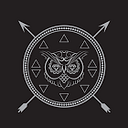Reading the Captivating Imagery of Last Exile
*Contains major spoilers for Last Exile*
by Blake Walden
At this very moment, you are likely either thinking “What the hell is Last Exile?” or “Finally, someone is actually talking about Last Exile!”
It’s one of those shows that came and went before the intervention of social media and never had enough of a fanbase to earn much in the way of critical discussion in the Youtube video essay space or the various written platforms where one discusses such subjects.
The Power of Names
“What is your name? — …I will remember it.” -Tatiana Wisla
It is my opinion that one of the best places to start when forming any critical analysis of a story and its characters is with the names of its characters. In Last Exile, these names betray an interesting intention on behalf of the creators. There are a few in particular that I want to focus on in this essay.
Dio Eraclea | Delphine Ereclea | Darius Ereclea
The Ereclea bloodline is the ruling family of The Guild, the most powerful faction within this fictional world. The Guild is an aristocratic religious order who dominate all other factions from on high, their ships ‘supervising’ the battles of other nations and manipulating the balance of power between Anatoray and Disith. These are lordly figures who conduct themselves as Gods, exercising a right to enter other ships (with or without a captain’s consent), interfering with battles and control of resources from fuel to water. As such, the name Eraclea is exceptionally suited.
Eraclea, from the Greek Herakles (Hercules), was the son of Hera and Zeus and the protector of Men. Eraclea means ‘Glory of Hera’, hinting perhaps toward Delphine’s wicked intent to seize power and her domineering attitude.
Dio can be taken with several different meanings, but the one I believe is most apt in this instance is ‘of Zeus’. There is also an association with Dionysis, the god of wine and pleasure and a son of Zeus. Dio is of course also the Italian word for ‘God’, tying the name and character even more closely to that of a deity.
Delphine is more straightforward. The only two notable meanings are ‘From Delphi’ or the far more likely ‘dolphin’. Dolphins are often associated with intelligence, guidance and transformation, all elements that occur with her character throughout the story. She is a cunning leader who uses her station to manipulate those around her against their will. All elements shared with the image of the Dolphin, though interestingly inverted from the usually positive connotations associated with the animal in the majority of pacific island cultures who view them as benevolent or merciful, two traits Delphine certainly does not share.

Darius, the Maestro of The Guild and patriarch of the Eraclea bloodline. Darius is a name worn by kings of Babylon and pharaohs of Egypt. The name is associated with wealth and guardianship, perfectly befitting a man who sits atop the most powerful faction in the world of Prester.
Each member of this ruling family is given a name with godly association, befitting of their station and role within the narrative.
Lucciola
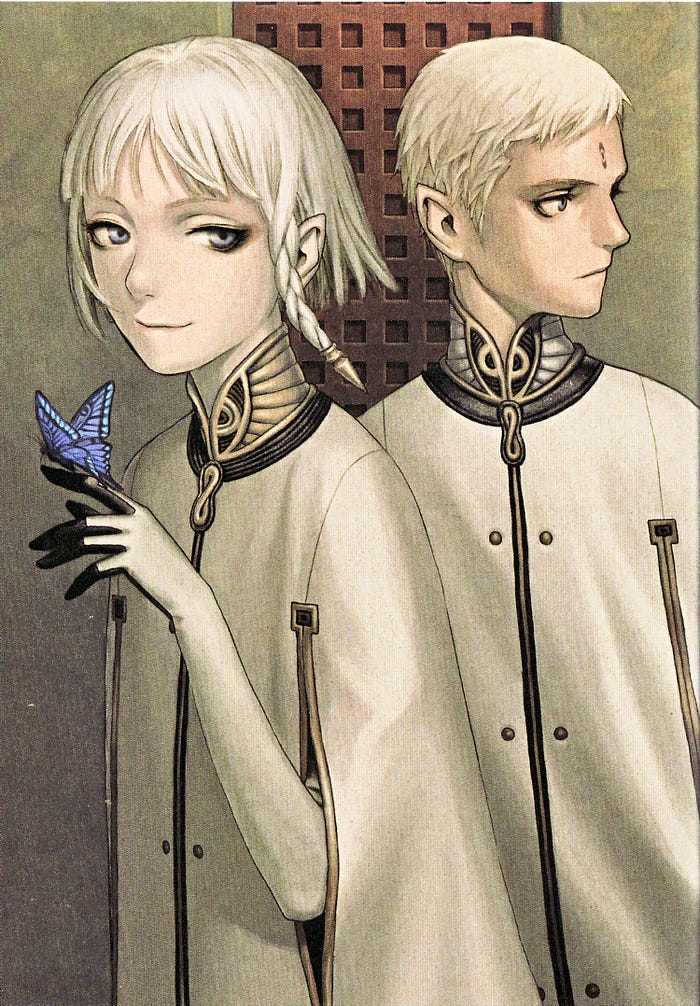
Lucciola was given to Dio as a ward when he was only a child. Given his slave-like position in their society, he bore no name. The name Lucciola is an Italian word and has the dual meaning of firefly and the vastly more interesting use of the word as a euphemism for ‘prostitute’.
Understanding both of these uses allows us to form a complete understanding of Lucciola’s place within the Guild and the characters around him.
All Guild members other than the Ereclea family that we meet is named for an insect, for example, Lucciola’s older brother Cicada. This informs the viewer of the hierarchy at play here and the manner in which the upper class of the guild view their subjects, as insects.
Of significant note however, is Lucciola’s use as a euphemism for a prostitute. Due to the fact that he is gifted to Dio, its intention is fairly clear however the function of their relationship with Lucciola serving essentially as Dio’s servant in place of a sexual partner does somewhat change its meaning. Lucciola is perhaps the most overtly oppressed individual in Last Exile, being used as a body to enable Dio’s will rather than being treated with any agency whatsoever.
He is revealed to be fed extremely poorly despite his proximity to the highest of powers in the Guild and the excess they live in and at several points of Dio’s early characterisation dismissed and disregarded. This is most evident in episode ten, Swindle, with Dio telling Lucciola to ‘just get out then-’ when losing to Claus and Lavi in the cavern race scene. This is a line that Dio repeats later in the show after the deterioration of his mental state and it utterly annihilates anything left of his sanity.
Claus Valca
Claus serves as our defacto protagonist after Lavi takes a back seat in the narrative. Once he begins entering combat with the crew of the Silvana, his piloting skills impress Dio, who takes a strong liking to Claus.
Let’s being with his name. The name Valca is related to the Italian word Valcare or Valicare which means to cross, overcome, surmount, pass by or transgress. Claus constantly breaks boundaries, as is common with protagonists, especially in anime.

He is one of the first people to enter The Guild from the outside, one of the few who navigates the Grand Stream and became a winner of the Horizon Cave vanship race on his first entry. These feats endear or antagonise him to the people who become his closest companions and set him up as a sort of figurehead of the resistance forces he intends to overcome.
Claus is a common German name that means ‘Victorious One’ and when taken with Valca can mean something akin to ‘One who is victorious in the face of overwhelming adversity’ or something to that effect.
Given his role as a figurehead and protagonist, it’s an exceptionally apt name, even if it does sound a bit too anime for some!
Manifesting Themes
There are several scenes and images in Last Exile that masterfully blend theme and motif to create compelling visual manifestations of its most important ideas.
One instance of this striking imagery is the carvings on this cavern seen in the opening episodes of the series. The image on the front of this cavern appears to be a female reproductive system, complete with orifice. This is most certainly not incidental.

After winning the Horizon Cave race, Claus and Lavi crash on a small rock just as the victory celebrations begin. As the two watch the fireworks from this rocky outcrop they have a heart-to-heart in which Lavi confesses that she doesn’t want to fly in combat anymore.
Set beneath the fireworks this is a gorgeous piece of imagery that perfectly foreshadows the battles to come and once again contributes to the ongoing theme of the beauty and majesty of flight and its inevitable application in war, a theme also heavily used by Hayao Miyazaki in his oeuvre.
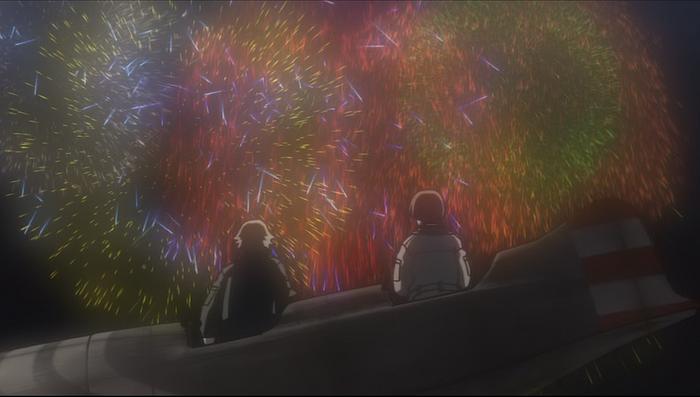
Perfectly framed, we see the fireworks occupy the space between them, Claus’ willingness to go into combat and Lavi’s resistance to it represented by the lights.
The primary setting of Last Exile is a spacecraft named Prester, which is divided into the kingdoms of Anatoray and Disith. Their names are heavily inspired by the Greek Anatole and Dysi, meaning sunrise and sunset. It only takes one glance at these two ‘maps’ of Prester to see why. These two factions are separated by the Grand Stream, a persistent current of extremely violent winds that can break even the most stable of ships and stoic of pilots.


In the image on the right above, we have a map created by Disith following the migration of ‘rainbirds’ Disith uses this migratory pattern to chart a course through the Grand Stream into Anatory as they flee the rapidly changing climate of their home.
On the left image above, we see a tree imprinted in the centre of the hourglass shape, clearly representing a World-Tree. Yggdrasil of Nordic myth, Irminsul of Germanic origin and Égig érő fa of Hungarian mysticism are all evoked by this image in this context. A tree is also symbolic of life and implies both mortality and age in a subject. This applies to Prester as well, as it approaches the end of its ‘life’ as a vessel. It is also worth noting that this reading is informed not only by the presence of the tree but of the absence of leaves, a symbol typically associated with illness, death & decay.
The hourglass shape of Prester is symbolic of inevitability and the passage of time. The decay of the climate in Disith is likely not a flaw of Prester but a design, the system beginning to fail after the 600-year Earth Regeneration Plan is complete and the various Exiles are signalled to return to Earth. The Hourglass motif is often depicted with wings to represent fleeting time and mortality. Within the context of the events of the narrative, it implies change as well; primarily the end of the Guild as a dominant force and the rise of the unified Anatory-Disith populations against the Guild.
Finally, it represents balance. When placed on its side an hourglass has no power, it is rendered null. Anatoray and Disith fight an ongoing war designed by the Guild to balance them, to maintain wealth, populations and materials within Prester until the Earth Regeneration Plan is completed and they can return to the restored planet.
The Game of Kings
The Chess motif is used in several places in Last Exile. It appears most prominently during episodes six and seven, where Lucciola and Dio are playing chess within the Guild Ship overseeing the battle between the Guild and The Silvana.

It also features in several of the episode names. Thirteen, Isolated Pawn, nineteen, Sicilian Defence and twenty-six, Resign, are among the more prominent examples, though there are several others. This motif reflects the nature of the plot, with the machinations of the various factions constantly shifting pieces and creating new power structures.
Chess is known as the Game of Kings, and with good reason. Historically, chess has been used as both an analogy for the positions one finds themselves in strife as well as a tool used by nobility to gauge critical thinking. Chess is a game that is very difficult to cheat at and much like how golf is used by the upper crust of society today, chess has served as a tool to determine the trustworthiness, cunning and intelligence of potential allies, business partners, rivals and friends.

In episode eleven, two old friends meet, sipping coffee and reminiscing on their youth. Now, each commanding their own vessels, they meet again as foes. Alex Row and Vincent Alzey are each dressed in White and Black, the colours of chess. Vincent, dressed in white, - backed by the might of empire and the new Urbanus-class ship - opposes Alex, dressed in black - the fugitive captain of the Silvana- who is constantly on the back foot.
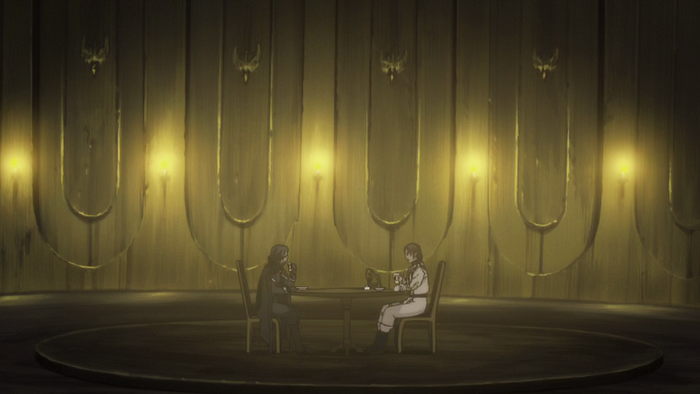
To cast Alex as the Black side of the board, it is indicated that he carries a noticeable disadvantage, just as the Black player does moving second in the game of chess.
Notable again is the image of the Hourglass within the version of chess played in Last Exile, with one of the pieces bearing the image of the Hourglass on it and once again indicating mortality and inevitability.
Anima Projection
One of the most significant and interesting scenes of Last Exile is in episode twenty-one, Rook Dio. In this scene we are presented with some incredibly interesting imagery that is highly suggestive of the sexual act, the incestuous intent of Delphine and the toxic masculinity projected onto young men, especially those who affiliate with queer groups.
In Episode twenty-one, we see the culmination of Dio’s fear regarding his sister Delphine, something he has displayed many, many times throughout the series up to this point. This subtle thread culminates in a scene of what I can only describe as enforced masculinity being projected onto Dio, and this is where the show is truly at its best.
Dio is forced to participate in a barbaric event called the Rite of the Covenant. On this Covenant Day, the guild gathers to watch as all those reaching adulthood in that year participate in the Trial of Agoon, an event in which they slaughter one another in a bid to claim the Sword of the Covenant and become the next Maestro of the Guild. Before this event, however, Dio is subjected to this enforced masculinity.

Dio is brought against his will to a fascinating room, rich with imagery. Here Dio is forced to enter a kiln-like chamber surrounded by Guild members wearing notably phallic headpieces, declaring their masculinity to the viewer. Notably, these figures are all men. On the floor, we see a white-gold pattern that undulates toward the chamber like a stream and above the chamber we see a collection of strange tubes.
During this scene, Dio is forced to enter this chamber against his will and emerges changed. Let's break down what’s really going on here and determine why.
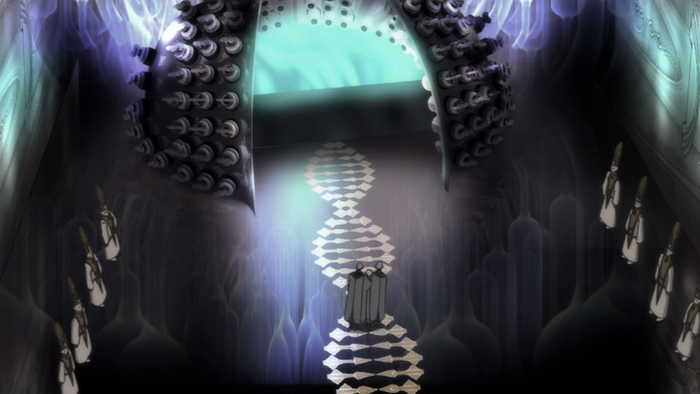
This scene is an allegory for the sexual act between a man and a woman. Dio is expected to perform this act before undertaking the Trial of Agoon, as a part of his rite of passage. In many cultures, males have not been considered adult men until they have lost their virginity to a woman (specifically to a woman, it is worth stressing). This chamber is shaped like a kiln very deliberately as the Kiln is used to forge things anew and has historically served as a surrogate for the womb in imagery. (The oven or kiln serving as a womb is prevalent in many ancient cultures due to the association with fire and fertility as well as the common effective shapes.) Dio is thus forced to enter this womb against his will, surrounded by men who are forcing him to commit this act.
The pattern on the floor is reminiscent of the male genital entering the womb, with Dio, a child, being forced along this path toward the womb. Dio being forced along this path is akin to the sperm being injected into the womb during the reproductive act. He is reborn after performing this act into something more easily pliable to Delphine’s will. Delphine has always preferred Dio in a more supplicant form, suggesting an incestuous urge.
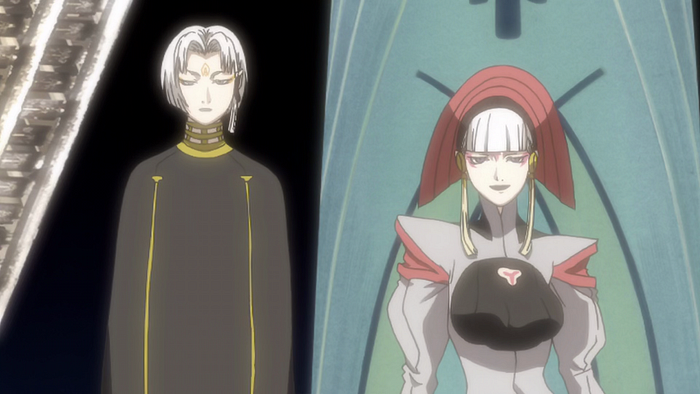
Dio emerges from it changed, emotionless and completely controlled by Delphine. The mark on his forehead is changed too into a more sapphic version of itself too.
Nymphlike and airy by nature, Dio cares little for the greater world save for that which interests him. He did not choose to be born or to be placed into the position he is in, just as he did not choose his sexuality. This, Delphine could not abide due to her incestuous urges and thus changed Dio into something she could dominate and project her beliefs onto.
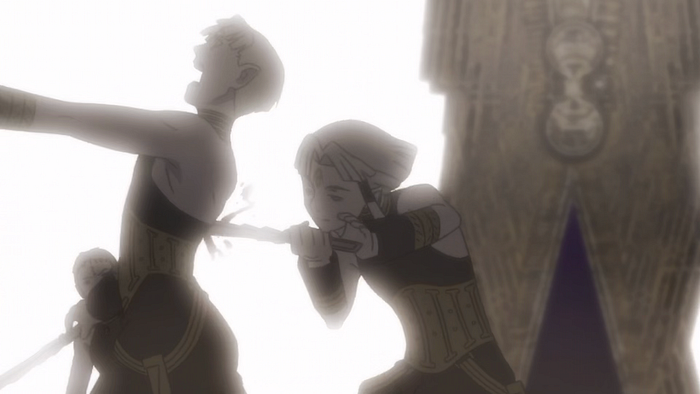
In his victory, Dio claims the sword of the covenant, a phallus that also bears the imagery of a cross (suggesting that masculinity is his cross-to-bear) and so becomes next in the succession of the title of Maestro.

Claus and Alister watch Dio as he engages in this violence, later discovering that his personality has been completely destroyed by Delphine’s enforced masculinity. Although Dio does appear in the sequel series Fam of the Silver Wing, it is highly suggested that he is lost to the gale of the Grand Stream when sent out by Delphine to kill Claus in a Vanship. During this mission he repeats dialogue from the Horizon Cave race including telling Lucciola to ‘get out’ and in his fractured mental state believes that he did so, Dio’s craft consumed by the wind moments later.
Without the context of the sequel Fam of the Silver Wing, one would naturally assume Dio’s death in this instance, which I believe to be a significantly stronger ending to his character that warns of the harm that comes from projecting one's own beliefs onto others. In particular, the barbarism of sexuality reforming tortures such as electroshock therapy & chemical castration that have historically been applied to the LBGT+ people of history. These procedures do not heal, they only open deeper wounds in an individual’s psychic health.
Last Exile says a lot with its limited run time and tight scope. The imagery creates depth and opens the show up to a level of analysis many of its peers don’t achieve. The significance of this imagery is stimulating to the viewer and provokes greater engagement than something without such a deep pool of symbolism to dive into. The consideration put into its design justifies its place among the titans of the medium and its execution places it as the peer of many to those loyal fans who have loved it for so long.
I hope this essay has been elucidating and scratched that Last Exile itch for the underserved fanbase out there. After watching this show in late 2022 I simply could not shake the feeling that there was more there to dive into and understand.
-Blake Walden
